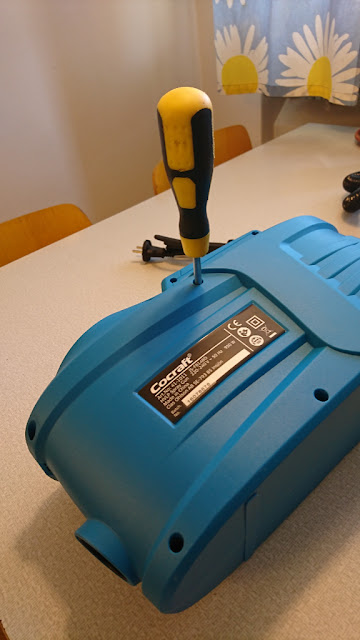So I've been eager to get a HVLP spray system for DIY stuff for a while. All the local outlets (Biltema, Jula, Clas Ohlson) carry one variant or another, typically costing EUR 50.
HVLP is basically a technique for applying paint on to a surface using large volumes of air at low pressure to atomize the paint, hence the acronym HVLP,
High
Volume
Low
Pressure.
The first HVLP-systems were based on a standard vacuum cleaner with a basic gun attached to the exhaust. Refinements followed, and as states in the US became stricter with allowable VOC emissions, the HVLP-technology boomed.
Nowadays, HVLP systems typically are based on a. a compressor setup with standard pressure hosing and a HVLP gun, or b. a turbine with larger hose and a special gun. The latter type is what the Clas Ohlson sprayer is all about. Apart from the lower overspray and reduced VOC emissions, the main advantage of this tech is you don't have to lug a compressor around.
 |
| In the box |
 |
| The machine itself |
The HVLP sprayer is clearly marked JS-FB14BD, and a quick search on the internets shows that this unit has travelled all the way from
Zhejiang, China. Unit cost for an importer is between USD 11-25.

Starting disassembly, one notes that the air inlet is not large. Really, I would have made it much larger - a significant amout of work will have to be done to suck air through the small filter when the filter starts to clog after having been in use for a while.
 |
| Flter section |
The machine itself is really nothing but a plastic shell with a couple of screws holding it together. Inside is the motor, a switch and some wires - nothing more.

So this is a 600W unit, which in turn presumably would make Clas Ohlson either liars (system is promoted as having a 950W effect) or not too a conscious sourcer of parts in Asia (i.e. someone sold them units out of spec).
 |
| Motor marked PowerX Motor Model PX-(D-2S)-600 |
The quality of the product shows when looking at the inside of the motor, exhaust-side: The carbon brushes cannot be replaced by any normal consumer. When the brushes have worn down, the unit has to be scrapped. Bad design.
 |
| Carbon bushed marked in red |
The gun is a run-of-the-mill type - bulky plastic to accomodate the one inch hose that attaches to the back of the gun. Some crude adjustments can be made using knobs.
 |
| The gun |
 |
| Gun viewed from rear port where hose attaches |
The nozzle has two fixed horns and is made from plastic.
 |
| Nozzle from front |
 |
| Fixed horns |
 |
| Nozzle ring removed |
The container is a no frills screw-on type with graduations in ml and oz.
 |
Graduated container
|
The suction tube is also from plastic, but what strikes me is the crappy foam gasket (white thing in the lid, see pic below). I would not believe this gasket to hold very well over time, and I am curious how it would hold up to some solvents.
 |
| Sucktion tube and gasket tat sucks |
The hose is standard PVC suction hose, which can be had by the meter at your local brick-and-mortar store (in Sweden: Bauhaus, Biltema or the like, cost around EUR 4/m).
 |
| Hose width 1"/25mm |
Hose length is around two meters. The length is probably this short due to the loss of pressure as hose length increases. Pro HVLP units typically have hoses several meters long, in order for the turbine to be placed far apart from the place where you are acually standing spraying.
 |
| Hose length ca 200cm |
So how did the gun fare? Well, after having discovered that there was no pixie dust inside and that it was out of spec, I returned it to the store and informed Clas Ohlson of their mistake. I can do much better that this myself with a proper HVLP turbine gun and an old vacuum cleaner. But that is another project.
I might add that technically, if you are only going to do some rough painting of, let's say some deck chairs, I believe this system would suffice. But any long-term usage would inevitably lead to so much wear on the plastic parts that they'd have to be replaced. Replacements
are avaliable, believe it or not, look below. But the needle is not in the spare-parts list...
 |
| Spare parts, screenshot from www.clasohlson.se |























Kommentarer
Skicka en kommentar